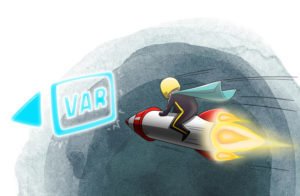
The VAR industry is currently being disrupted by a combination of factors. Most significantly:
Software as a Service and Public cloud are growing. The consequence of this increase, is a decline in large infrastructure projects.
Clients who are looking for these larger projects have the choice of management consultancies as well as VARs for project execution. For clients who see these projects as high level strategic/management moves, the business consultancies may be a more natural fit and the opportunities that come out of these engagements require different skill sets and ways of thinking that aren’t commonly associated with VARs.
Clients are looking less for ‘IT services’ and instead want ‘Digital Transformation’.
What does this mean for VARs?
It boils down a very simple outcome. Demand is decreasing for the traditional services VARs offer – in other words, the market is shrinking. In order to survive, VARs are going to have to make a choice. They can either consolidate to create efficiencies of scale and gather up more of the market or make a shift in the products and services they offer to stay in the game.
When researching these trends, we’ve found the following:
– Demand for ‘Managed Services’ has decreased by 35% since 2012.
– Demand for ‘IT Solutions’ has fallen by 50% since 2013.
– Demand for ‘Networking’ has fallen by 60% since 2013.
Conversely, demand for ‘Digital Transformation’ has increased by 400% since 2014.
What’s driving the change?
The public cloud is a major force behind these changes. Clients can now adopt public cloud services themselves which means they forge a relationship directly with their provider – negating the need for the VARs services at all.
This relatively new capability is also changing the way software is created and implemented. Nimble, agile software providers can now move from idea to implementation of a test solution incredibly rapidly – long before an on premise solution could be specified and installed. This functionality has attracted the attention of management consultancy firms and has increased their appetite for technology projects, sharpening up their ability to execute.
Not only that, but we’re seeing more and more technology becoming commoditised. For example, building a website used to be solely in the domain of technical experts, but now there are lots of options to purchase templates and website builders that are easily modified by non-technicians. There are lots of companies who make the whole process extremely easy for their customers.
As a result of these combined changes, we’re seeing increasing consolidation in the VAR industry – a hallmark of a mature industry starting to decline.
Where does Digital Transformation fit in?
There is still some quite confusing information around as to what Digital Transformation is. Many conceive Digital Transformation as digitising products and services. Others think that it’s about technology. Yet others believe that Digital Transformation is first and foremost a different way of thinking, and this is the camp we fall into.
Experience shows that those who have gone down the route of digitising products and services – building websites, apps, e-commerce, portals and so on eventually find that these activities don’t make a fundamental difference to the performance of the business. Digitising can make a customer’s experience easier and more convenient, but the simple fact of having a website doesn’t mean new customers are going to find you. In many cases, it just means a change in how your existing customers interact with you – they may choose to use your services or purchase your products online rather than visit your premises. That’s not to say that digitising your services isn’t a worthwhile activity, it most certainly is. You may well risk losing customers to a competitor if you don’t have the digital capabilities that today’s customers have come to expect.
Digital Transformation starts by looking at things differently and asking a series of questions. Rather than asking how technology can help us to provide a better service, we start with asking what services or products do people need or want? How well placed are we to meet that need? What do we have that we can leverage to create a competitive advantage?
We need to find out how many customers are looking for your products or services. Where are they? Why do they want them? What task are they trying to complete? What are they trying to achieve? What is standing in their way? Do they want education? Do they want to buy? How much do they want to spend? Can we as a business offer a better solution than our competitors? Who are our competitors in the digital world? Can we displace them? Are we doing anything differently to them? Are we offering something unique and valuable? If not – can we? How would we know if our ideas will work?
Technology discussions come much later in the process. Only when we understand what it is that our customers want to do and have established how they want to go about it do we start looking for the technology solutions to make that as painless, convenient and efficient as possible.
Making the leap from being a value-added reseller to a Digital Transformation expert
First and foremost, VARs must make the required upgrade in thinking that precedes the upgrade in technology.
The technology part is taken care of – the expertise is there. VARs can see the value in the technology and understand how to use it to help organisations perform better and find the solutions to their challenges. They are well placed to fulfil this part of the bargain.
The challenge is in becoming the go-to guys for the preceding diagnostic part. It’s in making the shift from solution provider to the being the people asking the tough questions and knowing how to find the answers.
It means being part of the boardroom discussions. It means understanding the critical issues facing the business, understanding the marketplace, the capabilities of the organisation, their customers and how to get the data required to underpin these critical business decisions.
The aim of Digital Transformation
The ultimate goal of Digital Transformation is for organisations to find and sustain a competitive advantage in the digital age. In the digital age things move and change rapidly. Organisations have to be outward looking, nimble, and engaged with their customers and their own people to innovate and co-create new products and services that add value to their customers. Digital Transformation permeates every level of the organisation from the top to the bottom including the structures, the operations and the communications.
Digital Transformation is strategic. The realm of the VARs is traditionally in operational efficiencies and best practice. It’s undoubtedly a big change.
These transformation projects are incredibly interesting and energising for everyone involved. It gives focus, it gives direction and it energises people to keep moving through the sometimes sticky process of change.
A transformed organisation is agile, nimble and fun and satisfying to work in and a pleasure to do business with.
Making the change is of course, entirely possible for VARs. Some will wish to transform themselves first before applying the methodology to their clients. Some will prefer to create a new wing or department for this consultancy role that will work alongside the business.
Are all Innovations Digital Disruptions?
Not all innovations are digital disruptions. Why? Because a digital disruption is more affordable, effective and convenient than anyone else in the market. An innovation may be effective, but without being all three of these elements it is not disruptive.
This is according to Clay Christensen, the Harvard Business School professor and Author of the Innovators Dilemma. Christensen explains:
“Disruptive innovation, describes a process by which a product or service takes root initially in simple applications at the bottom of a market and then relentlessly moves up market, eventually displacing established competitors.” You can read more about Clayton Christensen’s key concepts here.
So innovations can be disruptive without being digital! A digital disruption is when the innovation is technology driven.
Quite often when technology is implemented, it can create micro marginal gains. Digital disruption on the other hand, tends to happen when companies create step change. The technology becomes accessible to everyone causing mass adoption. When mainframe computers were first built they filled whole rooms , cost millions and you needed a PDH to be able to use them – they were not affordable, effective or convenient! Now we may have several computers in our homes from desktop to laptops and tablets.
To put this in perspective, when businesses tweet more or do SEO better they may find smaller marginal gains. However, when organisations change their digital business strategy, target new markets and bring in transformative technology, it is then when they find step change. It is this step change that will lead to disruption.
How do VARs create the change?
Using a framework provides the structure and process for planning strategic business moves. Using our framework also gives you the language and tools to talk at boardroom level and provide that common understanding of the digital landscape and the moves we can make within it. There are software tools and training available for VARs who wish to make the shift into Digital Transformation and we would love to hear from you if you would like to hear more about how we can help you.


